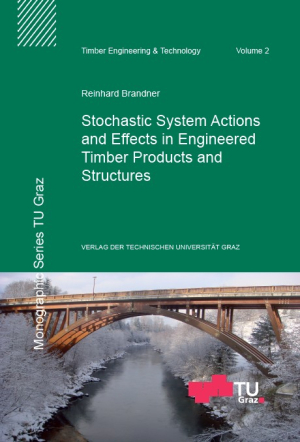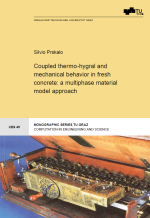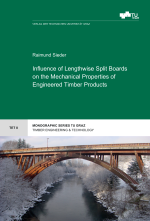Timber constitutes a fascinating and sustainable natural material. It is competitive even against latest technical materials if the ratios of strength and stiffness to density are compared. The processing of trees to timber impacts the naturally optimised structure and increases the variability in physical properties. This will lead to a minor degree of utilisation if the timber is used for structural purposes. The motivation is to change this circumstance by composing smart system products.
Within this work a universal applicable approach is introduced. It subdivides materials and structures in serial and parallel (sub-)systems. Based on stochastic material models, the serial and parallel interaction of elements in systems is investigated. Hereby the focus is on elements with lognormal properties.
Empirical models, that even allow approximating the distribution of system properties, are presented.
With focus on timber and its hierarchical structure, which is discussed on the natural and technical scales, analogies to system products, structures and failure scenarios are presented and a qualitative approach to account for scaling effects is discussed. The applicability of prior to this developed models is demonstrated exemplarily by modelling and verifying properties of systems composed of timber elements. Hereby the hierarchical material structure and the spatial correlation of properties within and between timber elements are taken into account.
Ausgabe: Open Access E-Book
ISBN: 978-3-85125-321-4
Umfang: 461 Seiten
Sprache: Englisch
Erschienen: März 2014
Reihe: Monographic Series TU Graz / Timber Engineering & Technology, Band Vol 2
Timber constitutes a fascinating and sustainable natural material. It is competitive even against latest technical materials if the ratios of strength and stiffness to density are compared. The processing of trees to timber impacts the naturally optimised structure and increases the variability in physical properties. This will lead to a minor degree of utilisation if the timber is used for structural purposes. The motivation is to change this circumstance by composing smart system products.
Within this work a universal applicable approach is introduced. It subdivides materials and structures in serial and parallel (sub-)systems. Based on stochastic material models, the serial and parallel interaction of elements in systems is investigated. Hereby the focus is on elements with lognormal properties.
Empirical models, that even allow approximating the distribution of system properties, are presented.
With focus on timber and its hierarchical structure, which is discussed on the natural and technical scales, analogies to system products, structures and failure scenarios are presented and a qualitative approach to account for scaling effects is discussed. The applicability of prior to this developed models is demonstrated exemplarily by modelling and verifying properties of systems composed of timber elements. Hereby the hierarchical material structure and the spatial correlation of properties within and between timber elements are taken into account.




